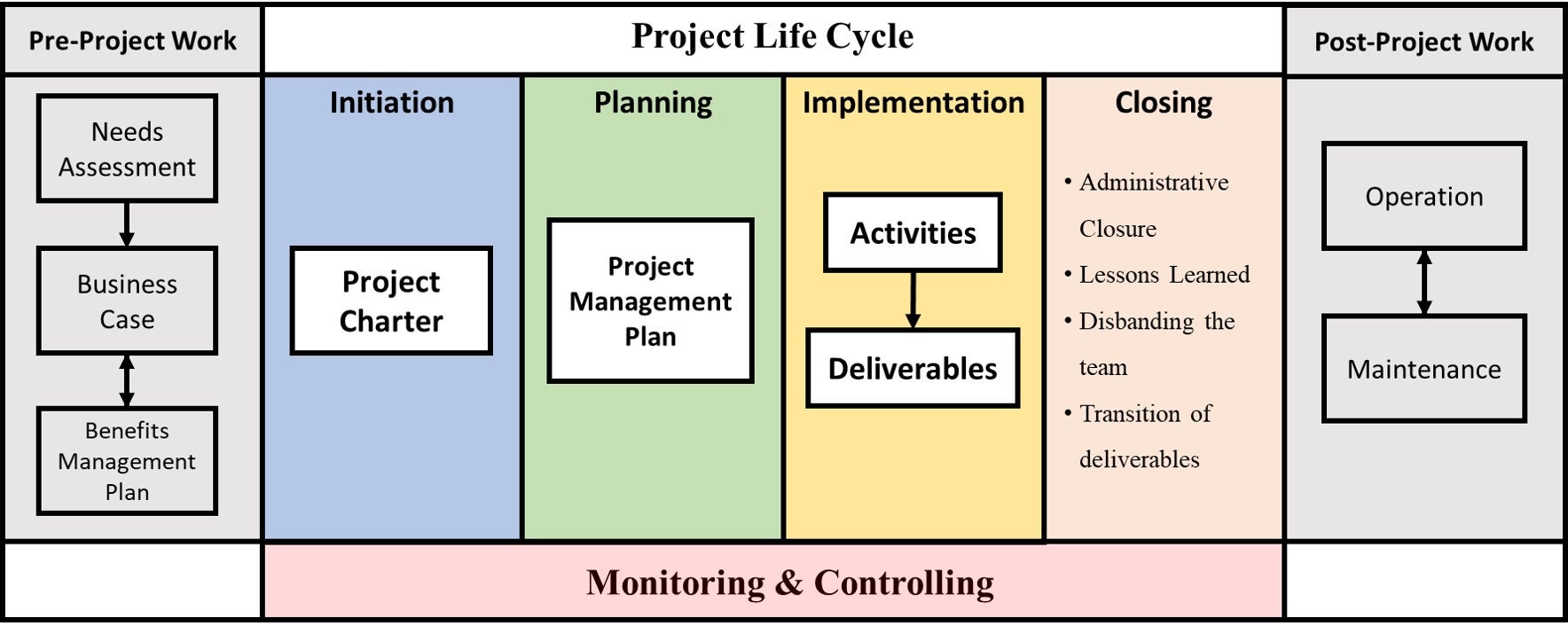Chapter 2. Strategy, Objectives, and Project Selection
2.3 Business Case
Organizations initiate projects to exploit business opportunities that are aligned with the organization’s strategic goals or eliminate business problems they encounter[1]. Projects are generally preceded by a business case that provides the economic, financial, and/or social feasibility and justification of the business need (Figure 2.2). However, some projects may be initiated in a short time with an order from the CEO or executive management team to address competitive measures, government mandates, or an exclusive inclination[2]. Hence, there may not be a formal business case that the project team can utilize to initiate the project. Nevertheless, in such situations, project managers are generally asked to conduct a needs assessment and feasibility study as well as a benefits management plan. Business cases aim to respond to a need, generally in the form of a problem or an opportunity, and they are generally prepared by business analysts in an organization in collaboration with relevant units and stakeholders.
A business case attempts to elaborate on the need for a project by providing an analysis of the current state, a description of the desired future state, and the actions to take to fill the gap between the current state and the desired future state. It also includes business, stakeholder, solution, and transition requirements, designs and recommended solutions generated according to these requirements, and the evaluation of solutions to understand the potential value of these solutions[3]. A business case is accompanied by a needs assessment and benefits realization management plan. A needs assessment often precedes the business case, and it is used to assess the current internal and external environments and current capabilities of the organization to determine the viable solution options that, when pursued, would help the organization meet the desired future state[4].

Source: PMBOK Guide 6th Edition
The value of a business case to the project is two-fold. First, it is used as an input in the development of a project charter during the initiation (starting, conceptualization) project life cycle stage. Additionally, it is utilized as input to identify stakeholders who may be affected by or may affect decisions, activities, or outcomes of a project[5]. Therefore, business cases are utilized as a basis for authorization of further project management activities.
A business case can also be described as an economic feasibility study documented to justify and establish boundaries for the project. The validity of benefits is established through two accompanying processes, which are business needs analysis and cost-benefit analysis. Therefore, the required investment to start a project to acquire the expected outcomes can be justified from a business standpoint.
While many business cases share common elements, each one is tailored to the organization in which it is used. A business case can be formatted based on the needs of the organization and/or the organization’s templates in its knowledge repository. The main components of a business generally consist of:
- Need statement (Underlying problems or opportunities)
- The cause-effect diagram (fishbone diagram) is a useful instrument in this stage to identify the underlying issues rather than describing the surface-level issues.
- If it is an opportunity, the main contributors are investigated.
- Statement of goals (Business requirements)
- Stakeholders and their requirements
- Analysis of current state and future state, and creation of a business change strategy
- Constraints, dependencies, assumptions, risks, critical success factors, and decision criteria
- Designs and alternative solutions
- Potential value (benefits and costs)
Although preparation of a business case and its accompanying documents are considered a pre-project work, project managers may also involve in this process, in particular, if a PMO (Project Management Office) exists in an organization, or the project initiation is requested from the top level or if it is an urgent request from a client.
Project managers or project steering committees use the information available in a business case to initiate the project, identify stakeholders, and develop a project charter. A business case helps create performance metrics that are utilized to measure the project success against the objectives whenever a deliverable is produced and the project outcomes are generated at the end of the project.
Business cases play an essential role during project selection. Project selection committees or senior managers assess all the business cases and their recommended solutions as candidate projects. Due to various factors such as time, budget and resource constraints, internal and external factors, and organizational strategic priorities and plans, organizations cannot put all the projects into implementation. The next section discusses the project selection criteria.
- Project Management Institute. (2017). A guide to the Project Management Body of Knowledge (PMBOK guide) (6th ed.). Project Management Institute. ↵
- Project Management Institute. (2015). Business analysis for practitioners: A practice guide. ↵
- International Institute of Business Analysis. (2015). A guide to the Business Analysis Body of Knowledge (BABOK guide), version 3.0. Toronto, Ont: International Institute of Business Analysis. ↵
- Project Management Institute. (2015). Business analysis for practitioners: A practice guide ↵
- Project Management Institute. (2017). A guide to the Project Management Body of Knowledge (PMBOK guide) (6th ed.). Project Management Institute. ↵

